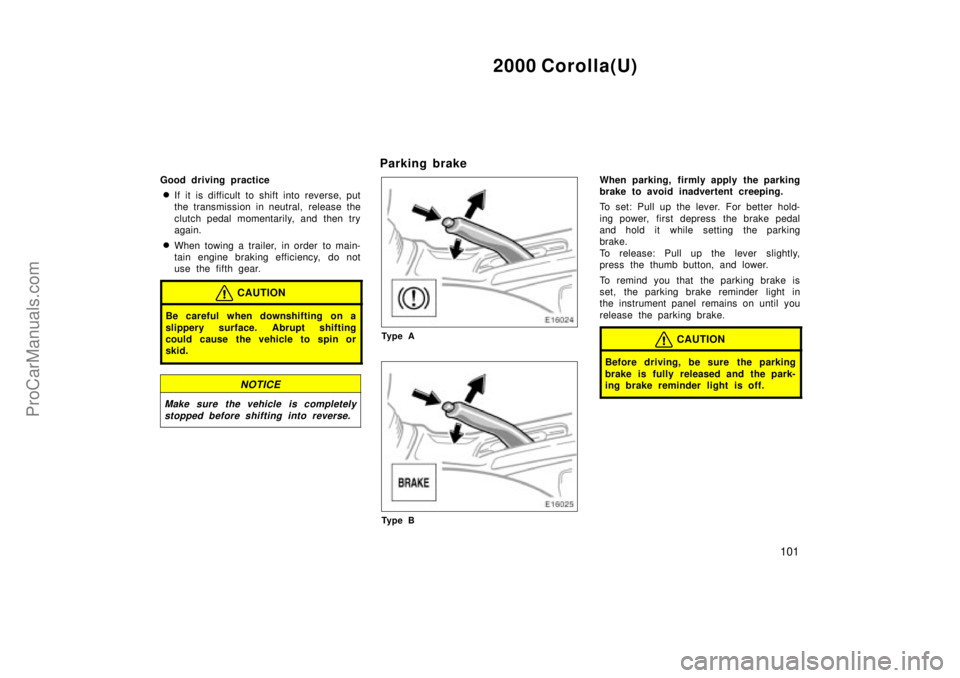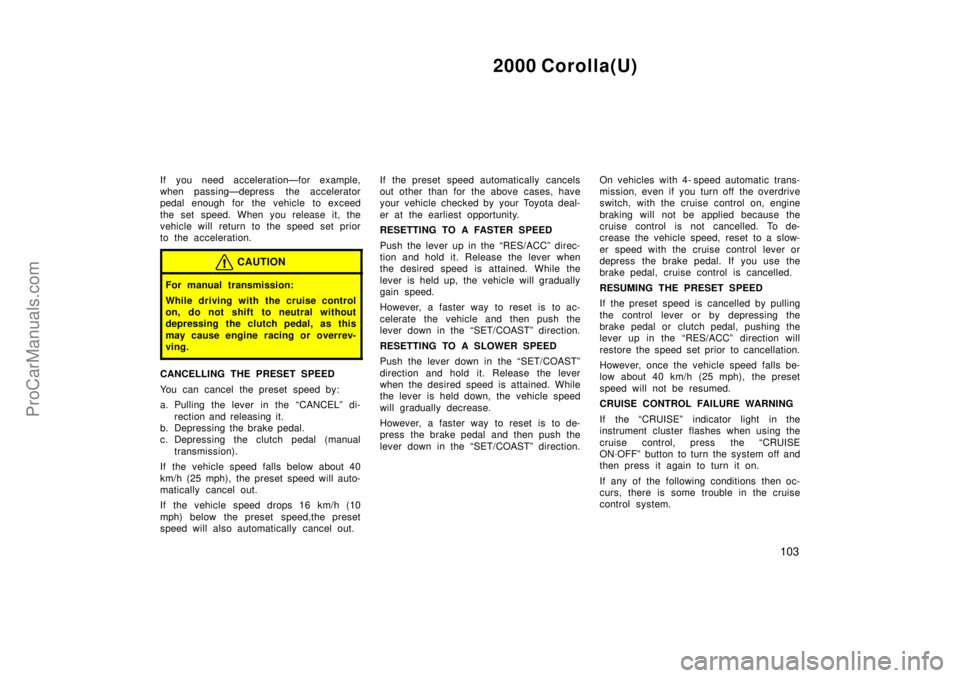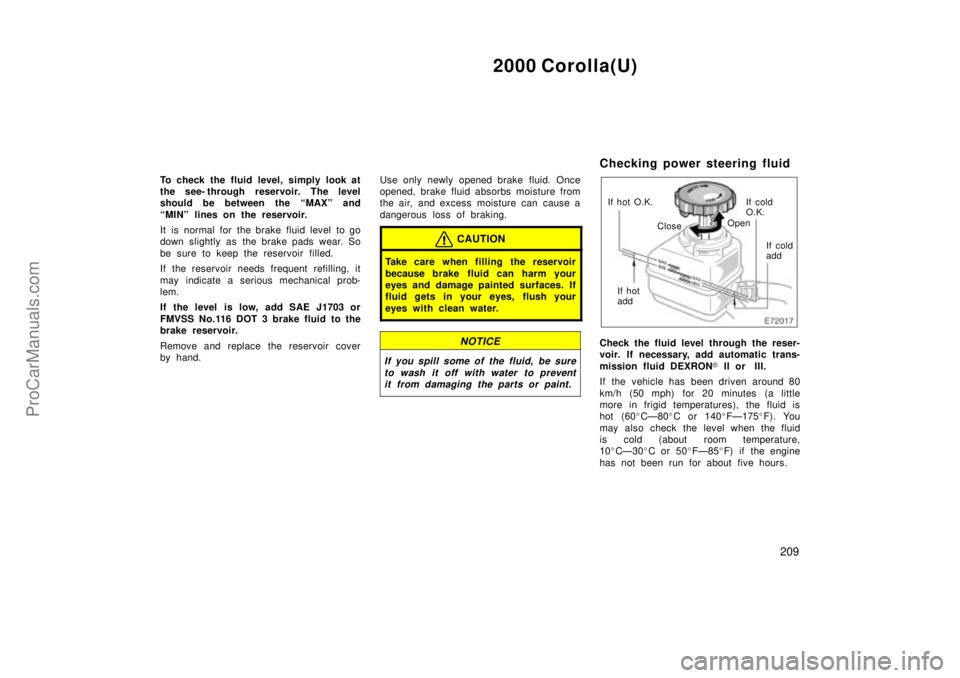Page 174 of 246

2000 Corolla(U)
100
Manual transmission
The shift pattern is conventional as
shown above.
Press the clutch pedal down fully while
shifting, and then release it slowly. Do not
rest your foot on the pedal while driving,
because it will cause clutch trouble. And
do not use the clutch to hold the vehicle
when stopped on an uphill gradeÐuse the
parking brake.
Recommended shifting speeds
The transmission is fully synchronized and
upshifting or downshifting is easy.
For the best compromise between fuel
economy and vehicle performance, you
should upshift or downshift at the following
speeds:Low altitude
Ð1219 m (4000 ft.) or lower
gear km/h (mph)
1 to 2 or 2 to 1 24 (15)
2 to 3 or 3 to 2 37/40
*
1(23/25*
1)
3 to 4 or 4 to 3 64/45*
2(40/28*
2)
4 to 5 or 5 to 4 72/64*
2(45/40*
2)
*
1: Under cold engine conditions.*
2: For constant- speed cruise or
constant- speed cruise after deceleration.
High altitude
ÐHigher than 1219 m (4000 ft.)
Upshifting
gear km/h (mph)
1 to 2 24 (15)
2 to 3 40 (25)
3 to 4 64 (40)
4 to 5 72 (45)
Downshifting
gear km/h (mph)
2 to 1 24 (15)
3 to 2 40 (25)
4 to 3 64 (40)
5 to 4 72 (45)Downshift to the appropriate gear if accel-
eration is needed when you are cruising
below the above downshifting speeds.
Upshifting too soon or downshifting too
late will cause lugging, and possibly ping-
ing. Regularly revving the engine to maxi-
mum speed in each gear will cause ex-
cessive engine wear and high fuel
consumption.
Maximum allowable speeds
To get on a highway or to pass slower
traffic, maximum acceleration may be nec-
essary. Make sure you observe the follow-
ing maximum allowable speeds in each
gear:
gear km/h (mph)
1 55 (34)
2 92 (57)
3 134 (83)
4 180 (112)
NOTICE
Do not downshift if you are going
faster than the maximum allowable
speed for the next lower gear.
ProCarManuals.com
Page 175 of 246

2000 Corolla(U)
101
Good driving practice
�If it is difficult to shift into reverse, put
the transmission in neutral, release the
clutch pedal momentarily, and then try
again.
�When towing a trailer, in order to main-
tain engine braking efficiency, do not
use the fifth gear.
CAUTION
Be careful when downshifting on a
slippery surface. Abrupt shifting
could cause the vehicle to spin or
skid.
NOTICE
Make sure the vehicle is completely
stopped before shifting into reverse.
Parking brake
Ty p e A
Ty p e B
When parking, firmly apply the parking
brake to avoid inadvertent creeping.
To set: Pull up the lever. For better hold-
ing power, first depress the brake pedal
and hold it while setting the parking
brake.
To release: Pull up the lever slightly,
press the thumb button, and lower.
To remind you that the parking brake is
set, the parking brake reminder light in
the instrument panel remains on until you
release the parking brake.
CAUTION
Before driving, be sure the parking
brake is fully released and the park-
ing brake reminder light is off.
ProCarManuals.com
Page 177 of 246

2000 Corolla(U)
103
If you need accelerationÐfor example,
when passingÐdepress the accelerator
pedal enough for the vehicle to exceed
the set speed. When you release it, the
vehicle will return to the speed set prior
to the acceleration.
CAUTION
For manual transmission:
While driving with the cruise control
on, do not shift to neutral without
depressing the clutch pedal, as this
may cause engine racing or overrev-
ving.
CANCELLING THE PRESET SPEED
You can cancel the preset speed by:
a. Pulling the lever in the CANCELº di-
rection and releasing it.
b. Depressing the brake pedal.
c. Depressing the clutch pedal (manual
transmission).
If the vehicle speed falls below about 40
km/h (25 mph), the preset speed will auto-
matically cancel out.
If the vehicle speed drops 16 km/h (10
mph) below the preset speed,the preset
speed will also automatically cancel out.If the preset speed automatically cancels
out other than for the above cases, have
your vehicle checked by your Toyota deal-
er at the earliest opportunity.
RESETTING TO A FASTER SPEED
Push the lever up in the RES/ACCº direc-
tion and hold it. Release the lever when
the desired speed is attained. While the
lever is held up, the vehicle will gradually
gain speed.
However, a faster way to reset is to ac-
celerate the vehicle and then push the
lever down in the SET/COASTº direction.
RESETTING TO A SLOWER SPEED
Push the lever down in the SET/COASTº
direction and hold it. Release the lever
when the desired speed is attained. While
the lever is held down, the vehicle speed
will gradually decrease.
However, a faster way to reset is to de-
press the brake pedal and then push the
lever down in the SET/COASTº direction.On vehicles with 4- speed automatic trans-
mission, even if you turn off the overdrive
switch, with the cruise control on, engine
braking will not be applied because the
cruise control is not cancelled. To de-
crease the vehicle speed, reset to a slow-
er speed with the cruise control lever or
depress the brake pedal. If you use the
brake pedal, cruise control is cancelled.
RESUMING THE PRESET SPEED
If the preset speed is cancelled by pulling
the control lever or by depressing the
brake pedal or clutch pedal, pushing the
lever up in the RES/ACCº direction will
restore the speed set prior to cancellation.
However, once the vehicle speed falls be-
low about 40 km/h (25 mph), the preset
speed will not be resumed.
CRUISE CONTROL FAILURE WARNING
If the CRUISEº indicator light in the
instrument cluster flashes when using the
cruise control, press the CRUISE
ON´OFFº button to turn the system off and
then press it again to turn it on.
If any of the following conditions then oc-
curs, there is some trouble in the cruise
control system.
ProCarManuals.com
Page 218 of 246
2000 Corolla(U)
200
Engine compartment overview
1. Power steering fluid reservoir
2. Engine oil level dipstick
3. Engine oil filler cap
4. Brake fluid reservoir
5. Fuse blocks
6. Battery
7. Engine coolant reservoir
8. Electric cooling fans
9. Windshield washer fluid tank
ProCarManuals.com
Page 222 of 246
2000 Corolla(U)
204
Checking brake fluid
Parts (if level is low):
�SAE J1703 or FMVSS No.116 DOT 3
brake fluid
Tools:
�Rag or paper towel
�Funnel (only for adding fluid)
Checking power steering fluid
Parts (if level is low):
�Automatic transmission fluid
DEXRON�II or III
Tools:
�Rag or paper towel
�Funnel (only for adding fluid)
Checking battery condition
Tools:
�Warm water
�Baking soda
�Grease
�Conventional wrench (for terminal
clamp bolts)Checking and replacing fuses
Parts (if replacement is necessary):
�Genuine Toyota fuse or equivalent with
same amperage rating as original
Adding washer fluid
Parts:
�Water
�Washer fluid containing antifreeze (for
winter use)
Tools:
�Funnel
Replacing light bulbs
Parts:
�Bulb with same number and wattage
rating as original (See charts in Re-
placing light bulbsº in Section 7- 3.)
Tools:
�Screwdriver
ProCarManuals.com
Page 223 of 246

2000 Corolla(U)
205
DO- IT- YOURSELF MAINTENANCE
Engine and Chassis
Checking the engine oil level206 . . . . . . . . . . . . . . . . . . . . . . . . . . . . . . . . .
Checking the engine coolant level207 . . . . . . . . . . . . . . . . . . . . . . . . . . . .
Checking brake fluid208 . . . . . . . . . . . . . . . . . . . . . . . . . . . . . . . . . . . . . . . .
Checking power steering fluid209 . . . . . . . . . . . . . . . . . . . . . . . . . . . . . . . .
Checking tire pressure210 . . . . . . . . . . . . . . . . . . . . . . . . . . . . . . . . . . . . . .
Checking and replacing tires211 . . . . . . . . . . . . . . . . . . . . . . . . . . . . . . . . .
Rotating tires212 . . . . . . . . . . . . . . . . . . . . . . . . . . . . . . . . . . . . . . . . . . . . . . .
Installing snow tires and chains213 . . . . . . . . . . . . . . . . . . . . . . . . . . . . . .
Replacing wheels214 . . . . . . . . . . . . . . . . . . . . . . . . . . . . . . . . . . . . . . . . . . .
Aluminum wheel precautions214 . . . . . . . . . . . . . . . . . . . . . . . . . . . . . . . .
SECTION 7- 2
ProCarManuals.com
Page 226 of 246

2000 Corolla(U)
208
CAUTION
To prevent burning yourself, do not
remove the radiator cap when the en-
gine is hot.
Coolant type selection
Use of improper coolants may damage
your engine cooling system. Your coolant
must contain ethylene- glycol type coolant
for a proper corrosion protection of your
engine that contains aluminum compo-
nents. Use TOYOTA Long Life Coolantº
or equivalent.
In addition to preventing freezing and sub-
sequent damage to the engine, this will
also prevent corrosion. Further supplemen-
tal inhibitors or additives are neither need-
ed nor recommended.
Read the coolant container for information
on freeze protection. Follow the manufac-
turer's directions for how much to mix
with plain water (preferably demineralized
water or distilled water). The total capacity
of the cooling system is given in Section
8.We recommend to use 50% solution for
your Toyota, to provide protection down to
about -35�C (- 31�F). When it is extreme-
ly cold, to provide protection down to
about -50�C (- 58�F), 60% solution is rec-
ommended. Do not use more than 70%
solution for better coolant performance.NOTICE
Do not use alcohol type antifreeze or
plain water alone.
Checking brake fluid
Ty p e A
Ty p e B
ProCarManuals.com
Page 227 of 246

2000 Corolla(U)
209
To check the fluid level, simply look at
the see- through reservoir. The level
should be between the MAXº and
MINº lines on the reservoir.
It is normal for the brake fluid level to go
down slightly as the brake pads wear. So
be sure to keep the reservoir filled.
If the reservoir needs frequent refilling, it
may indicate a serious mechanical prob-
lem.
If the level is low, add SAE J1703 or
FMVSS No.116 DOT 3 brake fluid to the
brake reservoir.
Remove and replace the reservoir cover
by hand.Use only newly opened brake fluid. Once
opened, brake fluid absorbs moisture from
the air, and excess moisture can cause a
dangerous loss of braking.
CAUTION
Take care when filling the reservoir
because brake fluid can harm your
eyes and damage painted surfaces. If
fluid gets in your eyes, flush your
eyes with clean water.
NOTICE
If you spill some of the fluid, be sure
to wash it off with water to prevent
it from damaging the parts or paint.
Checking power steering fluid
If hot
addIf cold
add If cold
O.K. If hot O.K.
CloseOpen
Check the fluid level through the reser-
voir. If necessary, add automatic trans-
mission fluid DEXRON� II or III.
If the vehicle has been driven around 80
km/h (50 mph) for 20 minutes (a little
more in frigid temperatures), the fluid is
hot (60�CÐ80�C or 140�FÐ175�F). You
may also check the level when the fluid
is cold (about room temperature,
10�CÐ30�C or 50�FÐ85�F) if the engine
has not been run for about five hours.
ProCarManuals.com